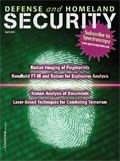Defending the Food Chain
Special Issues
The sobering reality is that homeland security is unique in the field of analytical chemistry. In an industry such as the baby formula industry, a change in process can end a contamination scare and for the most part, prevent a future recurrence.
The sobering reality is that homeland security is unique in the field of analytical chemistry. In an industry such as the baby formula industry, a change in process can end a contamination scare and for the most part, prevent a future recurrence. Likewise the peanut butter and dog food industries, which have gone through similar scares in the past few years. Even water purity issues can be resolved successfully by and large, with new regulations on acceptable limits of toxins preventing further illnesses, as can issues inherent in the pharmaceutical production process.

David Walsh
However, in the field of homeland security research, there often is no finish line. The opponent in this case is an intelligent one that can intentionally change shape and appearance at will. Even though techniques and technologies exist to identify trace explosives, anthrax virus, and more, as the Christmas Day bombing attempt illustrates, there will never be a technology to prevent someone from attempting to harm others. Because of this, the area of homeland security research remains one of the most important in the field of analytical chemistry and in society as a whole. The mutable nature of this field and the changing targets faced by researchers are reflected here, in this edition of "Defense and Homeland Security."
Here, you will find articles on topics you would expect, such as explosives detection and CWA detection. However, tellingly, there is more content devoted to identifying forgeries than ever before. With false documentation paving the way for most terror attempts, this is a hotter area than ever before, and requires an immediate response on the part of the research community.
As always, we hope you will find this supplement useful and valuable in your everyday work, and in addition, we hope it helps readers discover a newfound appreciation for those researchers on the front lines of defense and homeland security research and the critical work they do. They certainly deserve it.

David Walsh
Editor-in-Chief

LIBS Illuminates the Hidden Health Risks of Indoor Welding and Soldering
April 23rd 2025A new dual-spectroscopy approach reveals real-time pollution threats in indoor workspaces. Chinese researchers have pioneered the use of laser-induced breakdown spectroscopy (LIBS) and aerosol mass spectrometry to uncover and monitor harmful heavy metal and dust emissions from soldering and welding in real-time. These complementary tools offer a fast, accurate means to evaluate air quality threats in industrial and indoor environments—where people spend most of their time.
NIR Spectroscopy Explored as Sustainable Approach to Detecting Bovine Mastitis
April 23rd 2025A new study published in Applied Food Research demonstrates that near-infrared spectroscopy (NIRS) can effectively detect subclinical bovine mastitis in milk, offering a fast, non-invasive method to guide targeted antibiotic treatment and support sustainable dairy practices.
Smarter Sensors, Cleaner Earth Using AI and IoT for Pollution Monitoring
April 22nd 2025A global research team has detailed how smart sensors, artificial intelligence (AI), machine learning, and Internet of Things (IoT) technologies are transforming the detection and management of environmental pollutants. Their comprehensive review highlights how spectroscopy and sensor networks are now key tools in real-time pollution tracking.